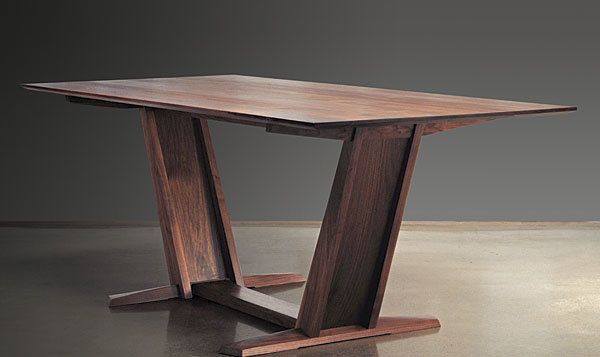A Personal Angle on the Trestle Table
Scale models and prototypes offer views not possible on paper
Synopsis: Eben Blaney set out to give the traditional trestle table a new twist. First he tilted the trestles outward to create angles and openings. Then he lowered the stretcher to the floor, opening an expanse under the table that pleased his eye. With these two major design decisions done, the rest of the design started to fall into place. See how this table evolved from prototype to finished product.
Eight years ago, after having built pieces to suit other people’s preferences for many years, I set out to find my own furniture style, my own design voice.
I’d been frustrated at times when I was asked to build pieces that I thought were overly embellished, so I challenged myself to simplify. For me this didn’t necessarily mean complete austerity, but a directness of design in which the visual details of a piece arise from structural and functional requirements rather than being added as pure adornment. This dining table with tilted trestles was one of the first major pieces I built in my quest.
Just before beginning the trestle table, I had made my “wedge” hall table, a piece that exemplified the direction I wanted to go with my work. The design of the hall table, with its radically angled plank leg, was prompted by my experience working on timber-frame structures: In those buildings, filled with vertical and horizontal lines, the angled bracing had an exciting visual power, a kind of arrested energy. I hoped that the hall table could provide a similar jolt when placed in a typical rectilinear room.
When it came time to design the dining table, I began thinking about trestle tables. I had built a few in the traditional Shaker manner—legs connected by a knee-high stretcher and secured with tusk tenons—and admired the structure. As I began drawing to explore a different approach, I had my hall table in mind, and I tried tilting the trestles outward. That created angles and openings that I immediately responded to. At the same time, I lowered the stretcher to the floor, and I liked the airy expanse above it and the more minimalist appearance that resulted.
I laid out a trestle full scale on a piece of 1⁄4-in. MDF to find what I thought was an attractive angle of lean. Then, using solid wood and hot glue, I made a quick 1⁄8-scale model so I could see the overall form in three dimensions. I liked what I saw, but there were details that I couldn’t resolve on paper or in the scale model, so I decided to build a prototype out of some red-oak lumber I had on hand.
As I built the prototype, one challenge I confronted was the feet. Like the feet of a more standard trestle table, they needed to be long and large enough to provide stability and strength at the connection to the uprights. but I wanted them to have a sleek profile and to express some of the slanting action of the trestle.
For the full article, download the PDF below.
Fine Woodworking Recommended Products

Drafting Tools

Compass

Stanley Powerlock 16-ft. tape measure




















Log in or create an account to post a comment.
Sign up Log in